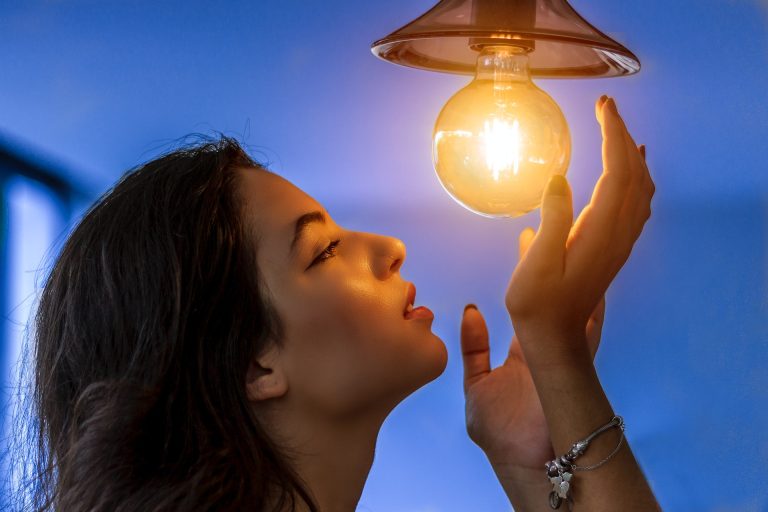Humans traditionally lived in diurnal, 24-hour cycles of light and darkness, with the day filled with natural light and the moonlit night enhanced only by the light of a fire. Under such lighting conditions, people would naturally labor during the day and sleep at night. They were all early risers who relied entirely on natural light from the sun.
Lighting has a tremendous influence on the human body. Natural light benefits people in various ways, including enhanced mood, greater energy, and improved productivity. Improper lighting can cause blurred vision, eye irritation, grumpiness, nausea, or headache… but what is proper lighting?
While over-exposure to sunlight can cause sunburns, sunstroke, and long-term damage to the skin, one should also consider the effects of artificial light on the human body.
These days, people labor day and night under artificial lights to achieve their goals. Afraid to waste time on sufficient sleep, we spend more time in the workplace, yet ironically, productivity does not improve. Our dependence on unnatural light sources may actually be sapping our energy.

Light influences the human body
Twenty-four hour availability of light is a relatively recent development in the timeline of human existence. With artificial light used to illuminate both indoor and outdoor spaces, we have pushed the progress of civilization, advanced science and technology, transformed the world, and altered our lifestyles.
Success
You are now signed up for our newsletter
Success
Check your email to complete sign up
While indulging in our artificially lit conveniences, we unwittingly become victims of so-called “light pollution.” It has an impact not just on individuals but also on the entire global atmosphere.
How artificial light affects us
According to an observation research analysis, exposure to light causes a photochemical response in the cell or tissue of the human body, affecting us both physically and psychologically.
- The light released by mobile phones, laptops, televisions, and other light sources has an effect on the metabolism of body cells or tissues.
- The pineal gland’s secretion of the hormone melatonin is disrupted, causing the body’s internal clock to malfunction.
- The suprachiasmatic nuclei (SCN), or central master clock in the hypothalamus of humans, is linked to a molecular oscillator, which keeps the clock oscillating at a constant rate. These internal biological rhythms fall out of sync, leading to the risk of developing CRSWD (Circadian Rhythm Sleep-Wake Disorders).
- As the circadian system is particularly susceptible to light-induced phase delays, artificial light can cause the circadian clock to be delayed, affecting sleep.
- The unnatural hues of artificial light impact our DNA, which plays a vital role in assisting in the successful performance of tasks under certain lighting conditions.
- To process visual stimuli in the environment, the retina, which is a thin layer of nerve tissue located at the back of the eyes containing the photoreceptors in the form of cones, rods, and RGCs, is impaired.
Basics of light
The spectral distribution of light describes the quantity of energy in the form of wavelengths. The recommended light intensity for normal work is 500 lux, with detailed work requiring up to 2000 lux. A closed office space may need supplemental fluorescent and LED lighting to meet this standard.
The retina is responsible for all of the known effects of light on circadian rhythms and sleep in humans. Different spectra influence the chronobiological effects of the circadian clock. When the sun goes down, the photoreceptors in the retina detect the change in light and send the information to the central master clock, which causes the body to sleep.
When the temperature changes, lit objects emit multiple light hues. The temperature of the light is stated in Kelvin, and observation demonstrates that the higher the color temperature, the cooler the colors, and the lower the color temperature, the warmer the colors. For this reason, the temperature of the light is critical in establishing humans’ comfortable working zone.

Lighting solutions for increased productivity
While it is preferable to work during the day, there are ways to improve your working conditions at any hour.
By choosing lower color temperature “blue-tinged” lighting, you can reduce eye strain and improve performance. Installing LED lights can reduce glare and stress on the eyes. A beveled light surface is another way to decrease glare, allowing for more comfortable reading.
A optimal 24-inch distance from your computer display should be maintained, and a protective screen with maximum UV filtering can help you work comfortably and productively.
Try your smartphone’s “night shift” option to change the screen’s color balance to the warmer hues depleted in short-wavelength light.
Another alternative is light therapy, an increasingly popular treatment, especially for seasonal depression. This therapy, which one can achieve at home with a specially-designed, UV-filtered lightbox, basically ensures that you get sufficient light exposure — albeit artificial — during the winter months.
By taking some of these steps to ensure you have the proper illumination, you can restore your natural rhythm. With this little edge, you may find yourself energized and anxious to get to work early, or lingering late without grumbling.













